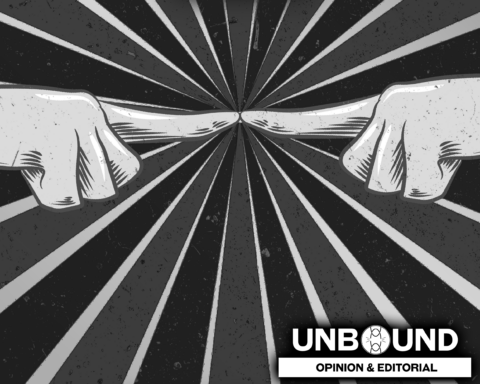“Don’t just do something, stand there.” The first thing to do in a crisis or even disaster is not to panic. This is not “fight, flight, or paralysis,” but steadiness, rooted in the inner security of faith. A national or international crisis is something that it helps to have a denomination to address, and an ecumenical movement. More than a disaster, a crisis or multiple crises requires more than sending money. It means aligning with those who seek a solution, and it may mean standing-symbolically and actually—with protesters and whistle-blowers. It means analyzing the obstacles to social change, which usually has a long range dimension.
In the current police accountability crisis, for example, Presbyterians may be helped to know that the General Assembly has endorsed peaceful protest and civil disobedience when necessary, and has called for de-militarizing (though not de-funding) the police. It has also, in the resolution, Honest Patriotism, identified the slow-motion crisis of lies and corruption damaging our society’s values and cheapening Christian faith. Having a strategy to address multiple crises is different from making multiple statements; it is about positioning and “pre-positioning” the church, and about thinking through the consequences of trends as well as emergencies.
Many church members continue to honor social distancing rules, watching live-streamed services, but the communal life of the church generally has been limited. There are fears that contributions will remain in decline even after physical gatherings are re-allowed. This article maintains that now is the time both to grow in faith at home—for those who are not “essential workers”—and for the church as a whole to grow its crisis ministry capacity. Because some level of crisis will be the new normal, I turn to the last comprehensive study of the church’s capacity to handle multiple crises, from 1983.
As this is written, 13 days of protests have followed the killing of George Floyd in Minneapolis, prompting demonstrations of solidarity in 700 other municipalities. In some places, aggressive police responses have increased public anger. Across from the White House, demonstrators were cleared by tear-gas in order to allow a photo op for the President and top aides in front of a damaged church. Right wing “3%” demonstrators hung the Democratic Governor of Kentucky in effigy next to his mansion in one of many small but heavily armed rallies calling for covid19 restrictions to be lifted—while the number of cases continues to climb. High unemployment continues with widespread bankruptcy threatening small and midsize firms, yet no substantial public works are authorized. Millions without health insurance defer needed care. Infected immigrants are sent back to Central America, spreading further illness…
In practical terms, after three years of epic levels of Executive Branch dishonesty and mismanagement, it requires a certain steadiness not to be confused or “hooked” by this or that outrage visited on one scapegoat or another. For any institution and the larger social order, not panicking means maintaining a stable and trustworthy process for decision making, whether it be properly authorized leaders making decisions on good information, or an electoral process free of subversion or interference. For many organizations, needed institutional steadiness comes from agreed-on policies, contingency planning, education, and leadership preparation. The church has the added dimension of grounding in tradition and in a worldwide family of faith. The church, in fact, should be well prepared for crises going back to the multiple firey darts of Ephesians 6, to which the answer is “stand, therefore” in the full armor of God.
The 1983 General Assembly Report
As part of its preparations for Reunion, the United Presbyterian General Assembly Mission Council organized a “Consultation on Crisis Response Capacity,” May 9-10, 1983, in St. Louis. Participants from Assembly agencies, presbyteries, and synods met with experts in various kinds of disaster response. Resources included historical overviews of mission areas (racial-ethnic, higher education, social witness, urban, women’s, overseas…) published by the Journal of Presbyterian History in 1979. Presentations were made on how the church might respond to different kinds of shocks occurring in combination, with an emphasis on how strong and flexible our connectionalism would be.
That report, then, was part of the social policy and planning tradition of the church that should be remembered as the United States government itself lurches from side-to-side, hobbled by one party’s commitment not to use the full capacity of the federal government to solve the problems of the nation as a whole. The Ephesians text explicitly tells the church to look out for the “principalities and powers” (cultural, political, and governmental forces) even when it is looking after the needs of migrant workers or unhoused people. Part of the church’s mission is to serve as an example of wisdom in the political sphere, at the same time as it serves meals. I will turn to that external dimension after looking at internal capacity assessment.
The 1983 study distinguished four kinds of crisis:
- Natural Disasters. To this could be added health crises like the current pandemic, intertwined with the climate change that the church was already recognizing.
- Wars, revolutions, large scale civil unrest. The massive displacement of Syrians due to that proxy war, for example, disrupted the politics of Europe.
- Economic Disruptions, recession, depression, etc. Technological and energy disruptions could add to “lean years” of mass unemployment.
- Socio-Political confrontations. This could include extreme polarization, which in the US has always had a strong historical racial element.
Clearly these aspects of crisis can overlap in various ways. Failed states, failed governments, vanished cultures and religions would be among the results; bankruptcies, church closings, divorce, addictions, suicide, lack of children can reflect crises on other levels, in some cases reflecting the failure to handle crises in communal ways with life-giving faith. The rise of inequality in the US has hammered and hollowed churches and other organizations dependent on an educated middle class with enough time and tradition for structured family life.
The church has special capacities to recognize the role of grief—the result of loss, and the nature of trauma. This is part of our growth in faith, even when isolated. Organizationally, Presbyterian Disaster Assistance (PDA) is adapting well to the holistic nature of crisis, and is developing more capacity for the church through a network of trained volunteers. Christianity as a tradition contains liturgical and symbolic forms of power that are resources for response precisely when material power (“lawyers, guns, and money”) is not available. In the teachings of Jesus—including the Christ of Matthew 5 and Matthew 25—there is a recognition of dignity for the suffering and a moral initiative that refuses the impulse to blame or abandon others. This moral distancing from evil is one of the social vaccines against narcissism, and it begins by recognizing that even healthy individuality is not enough. The response of faith includes prophetic judgment—the word, “crisis,” in Greek, includes separating and judging—so that each tipping point means a turning point of repentance and re-direction.
General Assembly “Early Warning Systems,” Education, and Networks
The 1983 study examined the role of “social education and action” (SEA; a predecessor of the Advisory Council on Church and Society, ACSWP, and the Advocacy Committees), as an early warning system in the church identifying causes as well as results of past and current crises. The role of a national and global church family was partly to broaden the horizon of members and reduce the ignorance and fear of others, while also representing God’s transcendent sovereign love in all spheres of life. For a long time most ecumenical bodies borrowed more from the Reformed approach of councils with annual assemblies and specialized staff rather than negotiating tables of bishops and other hierarchs.
The annual General Assembly debates over policy—the thinking through of data, analysis, theology, and planned action—helped the UPC and PCUS participate to varying degrees in the anti-racism and anti-war movements. “Consequently, each General Assembly meeting became a massive educational vehicle, involving ten days of intense interaction between leaders at all levels. In this way, critical mission issues were hammered out and disseminated throughout the church.” (Minutes, 1983, p. 242).
To strengthen staff relationships, in the former United Presbyterian Church,
“Before the 1972 restructure, there were annual meetings of the churchwide staff of each of the three major agencies: National Missions, COEMAR, and Christian Education. These were leadership development and team building events. There were funds and programs for specialized training, such as the urban mission cadre, the race staff, SEA seminars, etc. Ecumenical meetings and programs, regionally and nationally, provided regular opportunities for exchange of ideas. These meetings provided leaders a place to reflect upon their denomination’s problems from a distance and to develop joint strategy with their peers in other denominations.” (ibid.)
Capacity and Areas for Change
The 1983 crisis study went into detail on the differences among leaders, managers, and crisis managers; between new structures and temporary organizations; between reallocation of funds and mobilization of new funds; and the role of social imagination in nurturing new leaders in times of turmoil and profound crisis. Notable in the tone of this report is the lack of cynicism about the church’s capacity to change and to be an agent of change, for civil rights, for women’s equality, and on international justice and peace. Some of the victories of the 1970’s—perhaps including the successful removal of a President from office for corruption—were still fresh, even though they acknowledged a church divided over sexuality issues and “culture wars.”
The report identified three big areas in need of more analysis and attention, still matters of concern today:
- The availability of crisis funds for “ministries other than relief and relocation.” As noted, PDA is addressing this, and ACT Alliance is doing it internationally. In my view, the ecumenical agency division between Church World Service and the National Council of Churches’ theological leadership needs to end, lest we have just another NGO and church leaders unable to develop experimental ministries.
- “Clarifying the authority to act between meetings of the Assembly.” The Church of Scotland, for example, retains a General Council for times like this when Covid19 has limited their General Assembly gatherings.
- “Dealing forthrightly with inter-judicatory and interagency difficulties that can thwart crisis efforts.” Today this might apply to mid-council structures, and other changes in the church’s ecology and sustainability. Perhaps a good rule with regard to consolidation would be, “seek simplicity and distrust it.”
Emergency Ministries in today’s Culture
To turn to our larger context today, with riots in major cities and threats of government violence in the name of “law and order,” we see much avoidable crisis.
Beyond the first concern not to panic, the second thing is to know what or who is pushing your community, small or large, to the limit of its capacity for suffering. This is to define the crisis in terms of its underlying factors, the structural weaknesses, and not mirror the panic or exploitation of the crisis by others. That phrase, “never let a good crisis go to waste,” is now often interpreted as: never let the opportunity to get in front of cameras go to waste. True leadership, based in service, is to see what existing or new capacity needs to be tapped or developed. Approximately 50% of the people grabbing airtime in any crisis may be adding to it to feel important or powerful, sometimes out of unconscious control needs or fear of disorder, and sometimes reflecting underlying social divisions and enemy-making.
Naomi Klein’s concept of “Disaster capitalism,” shows how powerful economic organizations can take advantage of a situation like New Orleans after Hurricane Katrina, when governments turn over their powers to corporations or large non-profits. Her concept can be applied to any suspension of normal accountability in an emergency. The fate of the Weimar government in Germany in the 1920’s and 1930’s is often pictured as a time when economic crisis—the Great Depression and overly punitive Armistice terms—allowed for authoritarianism to create the Nazi-Hitler monster, a particular form of fascism, but not the only kind.
Any organization can be caught by the genuine need for a strong leader taken too far: disaster ecclesiology in hierarchical churches, ethno-nationalism in countries with majorities of one ethnic or racial group, and the combination seen in some countries of religion being politicized to justify oppression of others. The vaccine of the Reformed tradition is the doctrine of original sin, famously amplified by Reinhold Niebuhr into Christian Realism, to recognize the need for power to be exercised and limited at the same time.
The US has been in a cultural crisis over its national purpose and use of power since the 1980’s. Forgetting the “lessons of Vietnam” occurred most intensely not in the Reagan-celebrated Central American wars of the 1980’s, though they fed immigration and official dishonesty, but in the Iraq and Afghanistan wars built on lies and alliances with warlords. Combined with globalization’s increasing inequality among and within countries (and an immense tax haven industry), government’s misdirection increasingly weakens the common good of infrastructure, education, healthcare, and response to climate change. Rightly and wrongly, identity politics helps give meaning when the nation state, through a dysfunctional electoral college and massive legalized campaign corruption, does not serve most citizens very well.
The church’s challenge, in a time of social distancing and no national gatherings, is to develop new forms of community and connectionalism. We must also still practice an open politics and engage our faith intellectually, drawing on our colleges, universities, and seminaries as much as we can. We need more regional and local ecumenism, especially when we are becoming more a cognitive minority in the culture. As a denomination, we are still called to create programs and practices that are examples and symbols of God’s care and redemptive energy, interacting with our society’s need for greater equality, social trust, green infrastructure, and a global re-imagining of Martin Luther King’s “World House,” with all its ecumenical echoes.
Such programs are forms of emergency ministry in culture built on consumption that will probably wallow in an unnecessary recession, still tied to an anthropocidal fossil-fueled economy. Whether it be in new mental health and addiction ministries, or transformations of buildings for changing communal practices, or public peacemaking with police forces and communities, the church does not need to wait for the political or economic systems to recover—though political and economic democracy are our traditions, too.
Ephesians 6: 12-18 (New Revised Standard Version), read as facing multiple crises and deliberate disruption and division, suggests the conversion of all weaponry to truthfulness, justice, peace, forgiveness, and solidarity:
“For our[b] struggle is not against enemies of blood and flesh, but against the rulers, against the authorities, against the cosmic powers of this present darkness, against the spiritual forces of evil in the heavenly places. 13 Therefore take up the whole armor of God, so that you may be able to withstand on that evil day, and having done everything, to stand firm. 14 Stand therefore, and fasten the belt of truth around your waist, and put on the breastplate of righteousness. 15 As shoes for your feet put on whatever will make you ready to proclaim the gospel of peace. 16 With all of these,[c] take the shield of faith, with which you will be able to quench all the flaming arrows of the evil one. 17 Take the helmet of salvation, and the sword of the Spirit, which is the word of God.
18 Pray in the Spirit at all times in every prayer and supplication. To that end keep alert and always persevere in supplication for all the saints.”
Chris Iosso is the General Editor of Unbound and the Coordinator for the Advisory Committee on Social Witness Policy in the Presbyterian Church USA.






Unbound Social